The Flagship of 1980
Unridden for twenty years, left standing in a shed and forgotten by its original owner, this lovely bike was under a cover of dust and in dire need of restoration. Made by Motobecane in 1980, this C5 was equivalent to the Le Champion sold in the US, but featured a Huret Success transmission and not a Campagnolo set which wowed the Americans. I love the gold paintwork of this bike and it’s nicely coloured decals which make it quite a thrilling find.
The Problems
The bike didn’t make it out unscathed from that long storage in a shed. Strangely enough, it was the chrome fork crowns that fared the worst and were heavily oxidised. Why, is an interesting question, but I can only assume that chrome is more prone to rust than a bike frame itself, which is protected by layers of paint. The fork crowns were the second thing that struck me after seeing this bike for the first time, after my initial thrill of seeing it’s beautiful frame. Next were the wheels; flat tubular tyres and crusty hubs, suffering from years of neglect. I wasn’t sure they’d be any use any more, they were seriously close to being nothing more than scrap.
Rust and Titanium
The Stronglight 105 ter black crankset looked in pretty decent shape, save for rusty dust caps. I’m not a big fan of the black finish of this model, I think the silver finish looks much better on any bike. Nevertheless it had survived well, unlike the poor Huret front derailleur which had been frozen in one position for decades, eaten by rust and now a strange golden bronze colour. It’s rear counterpart had come off much better, having a titanium body and therefore immune to oxidation. The Weinmann brakes were now the colour of clay and under a coat of grime, but I could see that the stitched leather grip and the superb Philippe Professional bars and stem would recover well.
The Dilemma
It’s amazing how quality parts recover when you think they could be destined for the bin; how they are able to shine once more, move freely and become perfect working machines after years of abandonment. Perhaps this is where the addiction is to restoring old bikes and classic cars, that great feeling of discovering a logo underneath years of dirt, seeing the shine return to forgotten beauty. Needless to say that after a lot of hard graft, cleaning off rust and road dirt, spider webs and hard dust, then polishing each part to the best shine possible, the difference was amazing. However, the wheels being badly affected by age, and needing new tubulars, it was going to be quite expensive to rebuild the bike to its original specification. It was a tough choice to make between a full restoration or parting it out.
It was the wheels that did it
For a complete restoration, this bike need a new set of wheels, and I’d already spent far too much on rescuing it from its original owner. Don’t get me wrong; I’d much prefer to restore than part out a bike of this quality. However, I believe it could be rebuilt into a more beautiful bike: with a new classic silver crankset, a better saddle, new wheels and a caring owner, this C5 frame set could be better than ever. The frameset is for sale on EBay for £79, which is a steal for a Columbus frame of this quality. Long live the C5.
Specs
- 58cm Frame Size, C-T, 58cm top tube C-C
- Columbus Tubing, Frame and Forks
- Huret Dropouts, Long Lugs, Chrome Fork Crowns
- Braze-On Mounting, Made in France in 1980
- Frameset Weight: 3134 Grams Complete with Headset and BB
- Huret Success Transmission
- Stronglight 105 ter Double Crank 53/42, 170mm Arms
- 5 Speed Super Champion/Alpin Tubular Wheelset, Wolber Tubs
- Challenge Pro Saddle, SR Laprade Seatpost
- Weinmann 605 Brakes, Medium Reach
- Philippe Professional Bars and Stem
- French Threaded BB, 22mm steerer, 26.6mm Seatpost


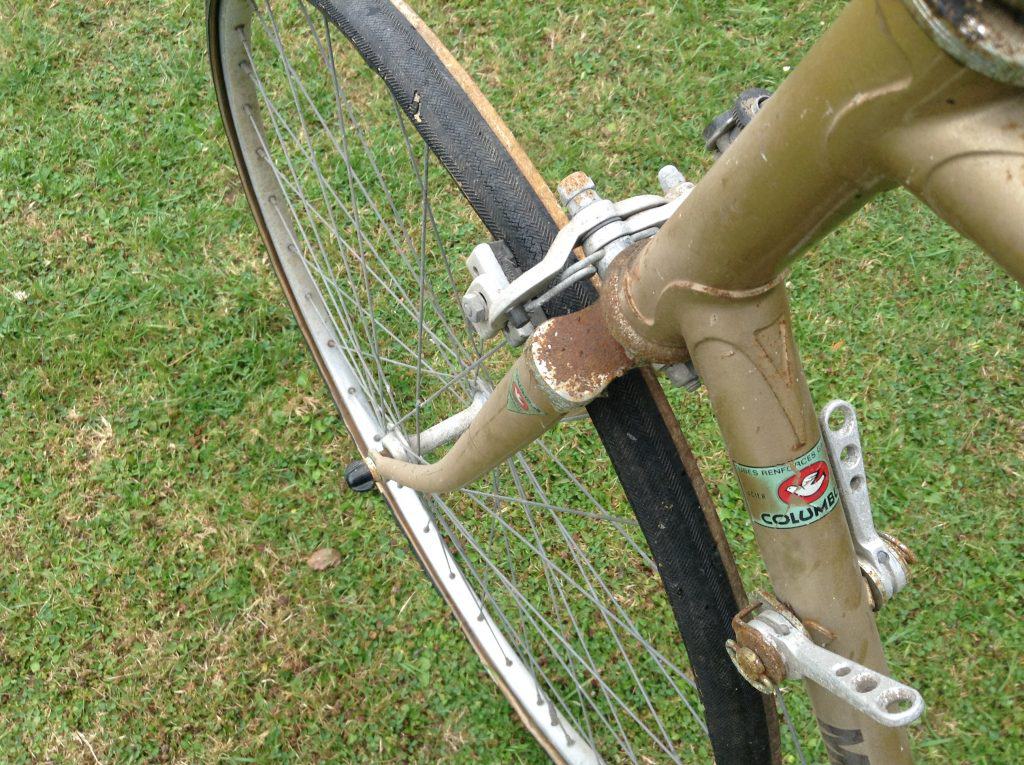
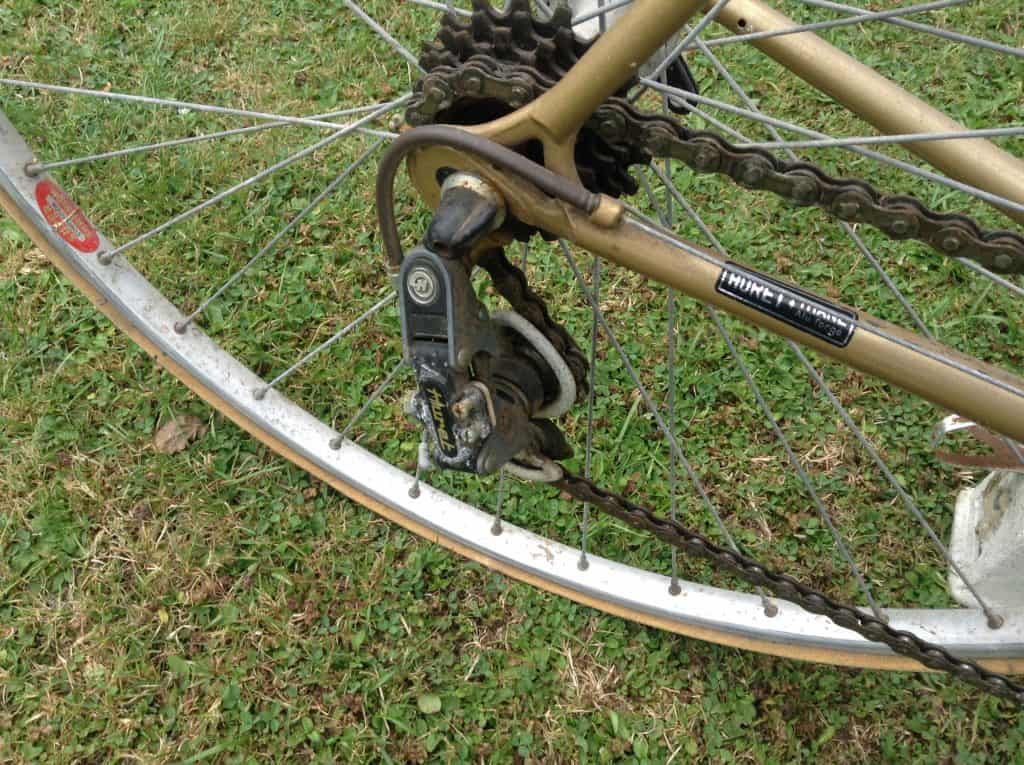
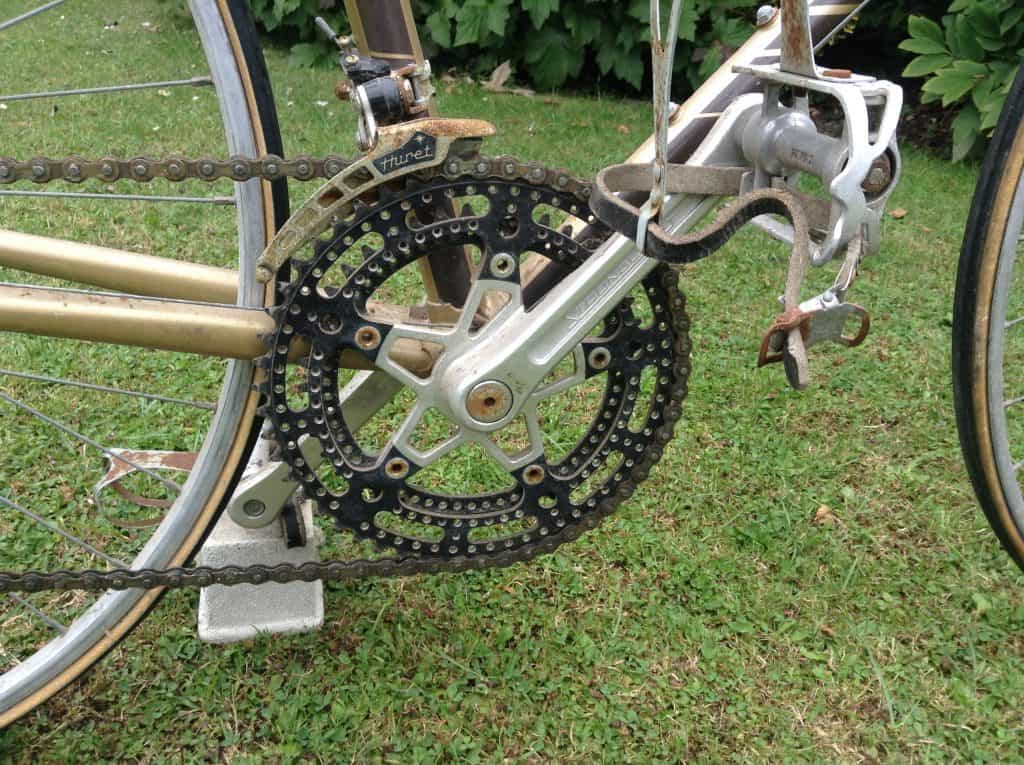
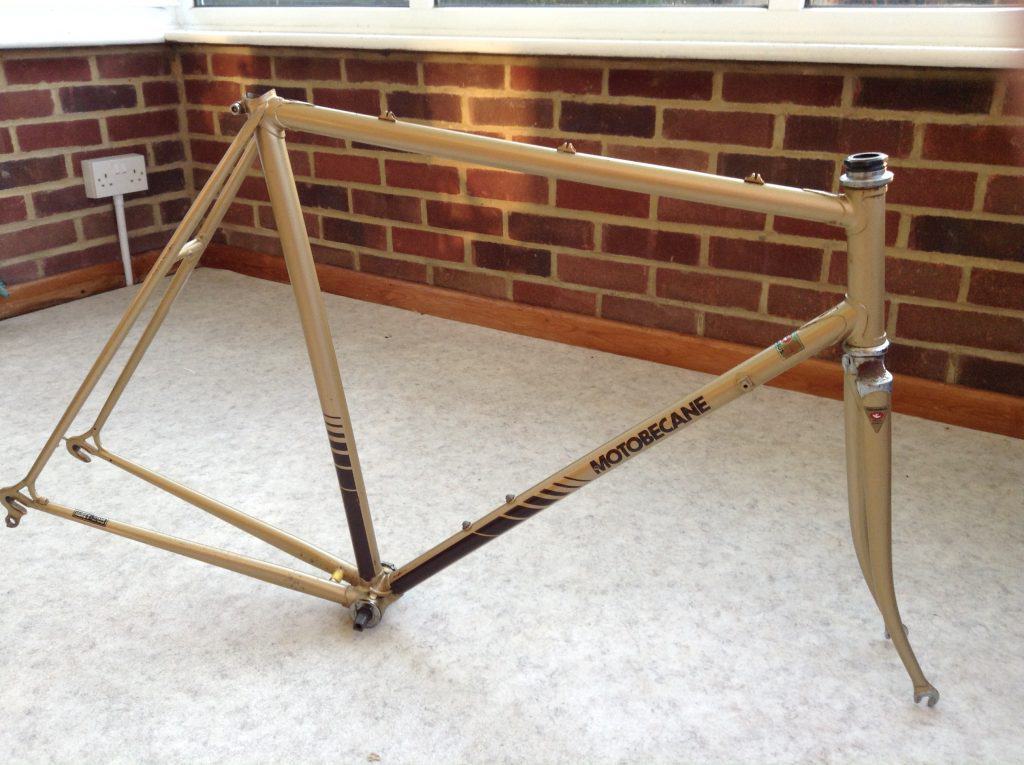
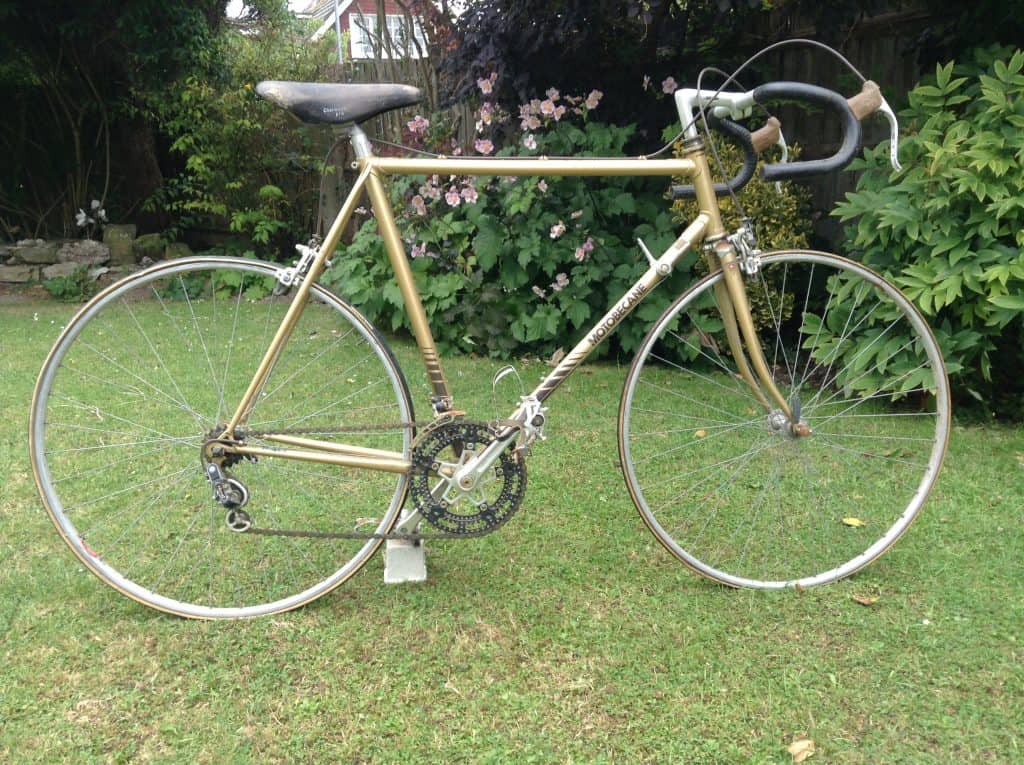
This bike is not a C5 but a C4c. The C4c was marketed in North America as,”Le Champion.” The C5 was marketed in North America as the, “Team Champion,” and in Europe as,”Le Tour de France.” In both cases the C5 was speced out with a full campy drive train. By 1980 the C4c’s for the North American market were equipped with the Shimano 600 Arabesque gruppo. Previous incarnations of both bikes were built from Reynolds 531 tubing. I’m not sure if the Columbus variant of the C5 was called the C5c because I always hear them referred by their name, but I would assume it to be the case.
Interesting comment, thanks for posting. However, I see the C5 in French Motobecane catalogues and from other French posts with exactly the same specification as this one. I haven’t encountered any C5 bikes sold in France with Campagnolo parts, but with these same Huret and Stronglight components. What was the difference between the C5 and the C4c in France?
After doing some more research, it seems there were some small variances in the Motobecane catalogues between 1978 and 1982. In 1978 and 1980, the C5 had Reynolds tubing, but in 1979 it was built with Columbus. Some C5 bikes of this period seem to have a chrome fork, but not all of them. I agree that a C4c was a Columbus tubed bike with this very specification, but as Motobecane changed their models regularly, it could have also been a C5 in another year.
To Barry J. Youll and Dominic,
If Barry and Dominic can comment I would like their Thoughts.
I took a chance on a no name frame sold as a possible European Motobecane Le Champion with no original decals nor original paint.
I probably paid too much, but seeing it came with original French sized headset, bottom bracket, and seat post and fork I thought it a decent prospect.
It looks like a 1979 Columbus tube Le Champion or Team Champion with cut out Lugs and Campy dropouts. The seat stay is finished with a concave fishmouth end as do other Columbus tube versions, including some Team Champions, which I guess it might possibly be.
The bottom bracket has distinctive 5 holes as do Columbus tube Team Champions and a 4 number serial number stamped horizontally across the bottom bracket shell as do other Columbus tube Motobecanes. The last 2 numbers 79 must be the date. 1979 associates with 3 braise on brake cable holders on the top tube, installed on all Motobecanes 1978 models and later,
Images of a 78 Reynolds Tour de France is missing the 5 hole bottom bracket shell ( No Shell Cutouts ) with a longish serial number stamped longitudinally around the perimeter edge of the bottom bracket shell rather than across the shell horizontally.
The only odd standout anomaly different On this particular bike and my bike from all is the placement and shape of the rear derailleur cable stop.
Most versions of the bike have the stop very close to the dropouts.the rear shifter cable stop on the chainstay is set back further from the dropout, Esthetically less cramped looking, Not crowding the dropouts as is the routine placement on most Motos, more in tune with normal convention. The Stop is more finely machined narrow at the bottom rounded on top unlike the typical uniform fireplug shape stop as on most Motos.
I noticed this singular feature on an image of a 1978 Reynolds Tube version Motobecane ” Tour de France” It was missing the cut out lugs, missing the fish mouth chainstay. Instead the Reynolds chainstay was finished with an oval flat top end and an embossed monogram M on the end cap. The fork crown also had an embossed M.
Any thoughts.
What is this bike?
Motobecane?
Le Champion?
Team Champion?
Tour de France?
Hi Barry, thanks for the comment, and it looks like you’ve done your research on the frameset you’ve bought. When you say a European Team or Le Champion, do you mean a C5, the European equivalent? As its a frameset and not a complete bike, it’s difficult to say exactly if it’s a Le Champion or Team Champion, but with all the info you’ve provided, I’d guess it may be the latter. Having a five holed bottom bracket shell and the horizontal serial number, that would be my best guess.
I don’t know if you’ll ever be able to be absolutely sure, unless you encounter a Motobecane officianado. Yet, I would hazard a guess at it being a 1979 Team Champion.
I hope someone else can add their opinion. Cheers!
Thanks for your input Dominic.
I forgot to mention that the French bottom bracket and headset, I’m assuming French also are Campagnolo. I figured these parts if still on the frame are least likely to be fussed with that is stripped off the frame, as the other parts and are original to the bike.
Having Campy dropouts With both Campy headset and Bottom Bracket at least one might surmise that the frame were a high end something.
As mentioned the 5 hole bottom bracket with horizontal serial number ending in 79 with top tube cable braise ons, beginning in 78 is compelling evidence of year and that the frame is a Motobecane. I would venture to say the frame is a C5 but would you know if Le Champion, Team Champion and the Tour de France are all C5s but with differing components.
Thank you.
Barry Blue
Hi Barry
Did you buy the frame from Europe, or in the US? The thing is, I don’t think the C5, which was sold in Europe, ever had a Campagnolo build. The American edition Team Champion had a Campagnolo groupset, including the bottom bracket, but the C5 came with a Stronglight bottom bracket. So I guess my question is, where did the frame originate? If it is an export to the US, I’d say it was a Team Champion, but without seeing its full build, it may be hard to know for sure.
Hi Dominic,
One may never know where bike was initially purchased. As you can see the white I bought one is virtually identical to Long Abandoned C-5 Motobecane. Only difference is chainstay end finish at the dropout and placement of he rear derailleur cable stop.
https://www.ebay.com/itm/Vintage-Motobecane-Le-Champion-61cm-Columbus-SL-road-bike-frame-fork-/202281883121?nma=true&si=uv1VWHE4axrcwkA90NrSSmi1SHE%253D&orig_cvip=true&nordt=true&rt=nc&_trksid=p2047675.l2557
Look at this Blue Team Champion
https://www.pedalroom.com/bike/1979-motobecane-c5-team-champion-27899
Look at the Blue Team Champion and Yellow Le Champion Bottom Bracket Shells. Identical to White frame However Both these bike have Huret dropouts and concave chainstay end and routine chainstay rear derailleur stop position.
https://www.bikeforums.net/classic-vintage/893741-motobecane-serial-number-database.html
Here is an earlier Orange Reynolds with the exact same rear cable stop and placement on rear chainstay but concave chainstay end
https://www.bikeforums.net/classic-vintage/809674-motobecane-champion-team.html
And Finally a 1978 Motobecane Tour de France Reynolds 531 identical machined Chainstay rear Cable Stop and Position on Chainstay but concave chainstay end
Thank You for your Opinion
Dominic,
Here is a Team Le Champion with the same details chainstay ending rounded instead of concave as the white one with Campagnolo dropouts.
As on the White it looks to be also missing triangular braise on brake bridge to seat stay present most Le Champion/Team Champion /Tour de France.
https://www.ebay.com/itm/vintage-MOTOBECANE-bicycle-LE-CHAMPION-road-bike-campagnolo-campy-vtg-brooks-sun-/142227767363?nma=true&si=uv1VWHE4axrcwkA90NrSSmi1SHE%253D&orig_cvip=true&nordt=true&rt=nc&_trksid=p2047675.l2557
Could the white Motobecane Not just be a transition frame with elements from older bikes and newer elements but perhap a prototype of some sort?
Hello. I just aquired a 1980 Team Champion with Columbus tjbing and a Cinelli bottom bracket
It came to me in great shape. The guy i bought it from had found it in by the curb awaiting refuse pick up
Wow, that’s a beautiful frame, congrats on such a find. Your frame is like the Holy Grail of vintage Motobecane bikes.
I just purchased this frame that I am told is a C5C or Team Champion. I came across this post and figured I’d give it a shot asking the experts what their opinions are on the frame.
More pics
Was hoping you might be able to help me identify this frame. I’ve been told it’s a Team Champion.